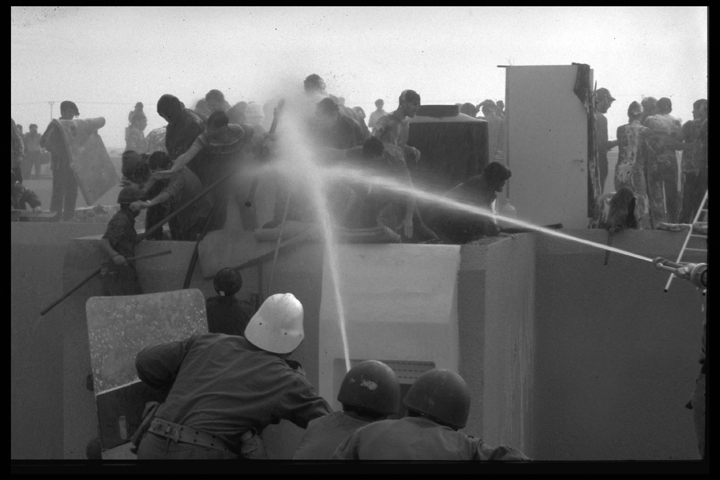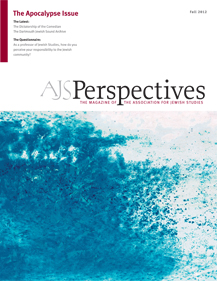
Zionism both inherited and tacitly nurtured an existential anxiety of nonbeing. As a movement of homecoming nationalism, the specter of failure was always a looming possibility, and the horrific price tag of such an outcome was spelled out through Jewish history, as it was told in Zionist historical narrative. This apocalyptic trepidation, though a basic underlying motif of Israeli culture, is often hinted yet rarely discussed openly in Israeli political discourse or in its vibrant public sphere. I want to inquire into this omnipresent yet invisible anxiety, mainly through the use of the Crusader analogy, presented in David Ohana’s new book, The Origins of Israeli Mythology: Neither Canaanites Nor Crusaders (Cambridge University Press, 2012).

Like other modern political myths, the Crusader story is based on sound historical evidence that received, through the years, mythical proportions, moral connotations, and simplistic narrativity. In that sense, the Crusader myth is no different from other Zionist political myths, such as Masada and Tel Hai. Those myths, however, had tangible manifestations in their heydays, such as places of pilgrimage, days of remembrance, and sacred texts that tied them into the national ethos. For the Arab world, the Crusader analogy operates as such a positive myth. Leaders such as Gamel Abdul Nasser, Saddam Hussein, and Yasir Arafat made frequent use of the analogy to signify their future victory over what they defined as the contemporary Crusaders. For Israelis, the Crusader story is a negative myth, characterized by silence, evasion, and alarm, never to be discussed in fear of weakening the national resolve.

Zionism defines itself as return to place, the homeland of the national collective. This declaration has three interrelated aspects. First, this place belongs to the Jewish people. Second, this place does not belong to others. Third, other places do not belong to the Jewish people, even after hundreds of years of continuous presence. The Crusader myth is subversive to all three premises. It raises the question of to what degree the land of Israel is the true and ultimate place of and for the Jewish people. Then it asks whether the place belongs to others, who will sooner or later reclaim it. Finally, it suggests that the true Jewish home is somewhere else, maybe Europe, maybe exile or Diaspora, and maybe the Jewish people by their very essence are not destined to find an eternal earthly home. In other words, the Crusader myth reflects the anxiety that the Zionist adventure is a reckless game of monumental proportions, committed irresponsibly by people who were never meant for heroic deeds such as building a state and a nation, and in general, participating actively, if not hyperactively, in history. It suggests that the transformation that Zionism wished to bring to the old Jew and the renovation that was proposed to the old land could be well beyond its powers.
The Crusader myth talks of return, yet not about the right of return, which is so dominant in the regions’ political discourses. It rather tells about reversal and negation of history as such, as the land returns to its previous owners and obliterates the remnants of the root-less invaders. Zionism cultivated a linear advancing narrative, promising its followers a better—obviously different—future. This is a version of the determinist modernist story, which replaces the old with the new and traditional millennia-long social and environmental realities with man-made inventions. The Crusader myth, on the other hand, implies a circular historical logic. To use Edward Said’s definition, the Crusader myth is a classical orientalistic expression, contrasting the West to an imagined East, describing how the Levant is concomitantly enchanted, primitive, and frightening, outside of the linear advancing history represented by the victorious West. The attempts of the West to modernize the Orient are by no means assured: the inertia of tradition may easily turn modern flourishing city back into desert.
When the Crusader myth questions the linear modernist historical narrative, it unsettles Zionism and brings back the suppressed, which in this case means the Arab, the Orient, the exilic and the old Jew, who, according to many critical thinkers today, hold similar symbolic place in Zionist mythology. It implies a strict binary division between East and West, not allowing for hybridity or the possibility of deep cultural change or exchange. With the radical otherness represented by the determinism of the Crusader’s myth, any option of merging into the area is ideologically declined. It is especially threatening when offered by Jews coming from Arab countries, a Trojan horse of a sort, that sees the surrounding culture as an alternative cultural option that holds advantages rather than being a mortal threat. Ironically, the apocalyptic fear can also be comforting. It tells the encircled people their essential core is immune to change, and that they are on the side of progress, modernity, and humanity.
There are two basic causes for the power of the Crusader myth, and picking between them is a matter of personal preference and ideological inclinations. One has to do with the unique connection of the Jewish people to its ancient homeland and to spatiality in general. In the book of Genesis, the land was promised to Abraham with these words: “Go forth from your land and your birthplace and your father’s house to the land I will show you” (Genesis 12:1). The land, the birthplace, and father’s house are therefore not considered to be the true homeland, while an arbitrary chosen land, at that stage holding no historical memories, belongs nevertheless to the not-yet-born people of Israel. Given by God, the land can just as easily be taken away, as exemplified time and again throughout the biblical narrative. In Jewish thought, existence on the land is inherently temporary, dependent on moral virtue. Zali Gurevitz and Gideon Aran (along with many prominent thinkers of the Jewish existential situation) noted that there always is the thorn in the mattress of the Jewish place, and the Jew can never sit comfortably anywhere.
The second reason for the anxiety is not as profound, and has to do with Zionism as Diaspora nationalism and its conflict against native people. The threat of evicting Jews, be it from the entire land or from certain parts of it, was prominent all through Zionist history, brought often to the negotiating table, and never far away as a concrete historical possibility. The overt threat made by many Arab leaders, leading to today’s Iran, was of politicide, namely the obliterating of the political entity, and often genocide. The anxiety is, therefore, a logical conclusion of the geopolitical situation, especially in the context of a colonizing national movement.
The traumatic memory of the Holocaust also nurtures fears that it may make a horrific return, and this motif has repeated itself in Zionist history leading to the present day. It is, however, important to stress the transformed meaning of such a calamity after the establishment of a Jewish state. Zionism was meant to give an answer to the exilic situation and to save the Jews from the possibility of further holocausts. Casting doubt on the solution, the Crusader myth is the virus that attacks the immune system, leaving the Jew with no safe haven. It therefore transforms the sacred memory of the dead into an ominous warning for the future.
Crusader anxiety can be found in seemingly confident political statements meant to bypass and negate it. Claims regarding the eternal belonging of Hebron or the Golan Heights, or that Yesha (Judea, Samaria and the Gaza Strip) is here, only pinpoint where the fears are strongest. The discourse of the left is no less explicit in its anxiety. Yitzhak Rabin’s slogan before the 1992 election was to extract Gaza from Tel Aviv, while Ehud Barak’s stance in 1999 was “We are here and they are there,” and later he offered his villa in the jungle metaphor for the Israeli geopolitical situation. The West Bank settlements have often been compared to Crusader fortresses. With the building of the separation wall on roughly the Green Line, the entire country is becoming one. Israeli political discourse needs constantly to produce and reproduce Israel’s distinction from its surroundings, while promising that the fate of the Zionist enterprise will be radically different from that of the Crusaders.
The common behavioral response to Crusader anxiety is active denial and the hyperactive construction of a reassuring reality. The obsession with construction—both actual and symbolic—is an integral part of the Zionist ethos. Making the desert bloom, covering the ground with a dress of cement, building ever more settlements, all contend with the primal fear of non-existence.
The possible return of the repressed is a recurring motif in Israeli literature. Following Walter Benjamin, authors ask if the destroyed absence still exists somewhere beneath the ground as a repressed presence, waiting for its chance to return, and some of the symbols they used were distinguishable and alarming. Amos Oz’s heroes heard jackals that symbolize the wilderness that preceded Jewish settlement, and in Meir Shalev’s novel the swamps make a surprising return. Young Israeli writers, such as Haggay Dagan, Eshkol Nevo, and Alon Chilo, have also found the national anxiety a thrilling challenge and fruitful inspiration for new literary inventions. Probably the most striking example appears in an early story from one of Israel’s greatest authors, A. B. Yehoshua. In his novel, In Front of the Forest, he wrote about the burning of the Jewish Agency forest built on top of a ruined Arab village. The deed was done by a mute old Arab, while the Jewish ranger was working on his dissertation—about the Crusaders, of all subjects. The repressed has never returned in a more dramatic fashion.
Being able to talk about existential anxieties may be a first stage toward a solution, though with Jewish memories and Israeli contingencies, a full “recovery” from the apocalyptic threat is probably far in the future. While apocalyptic anxieties may have their functions, they are not always the best guidance for an informed policy. The evolvement of Israeli society, demographics, and politics, as well as the transformation of its geopolitical environment, may eventually put the Crusader myth to rest.

